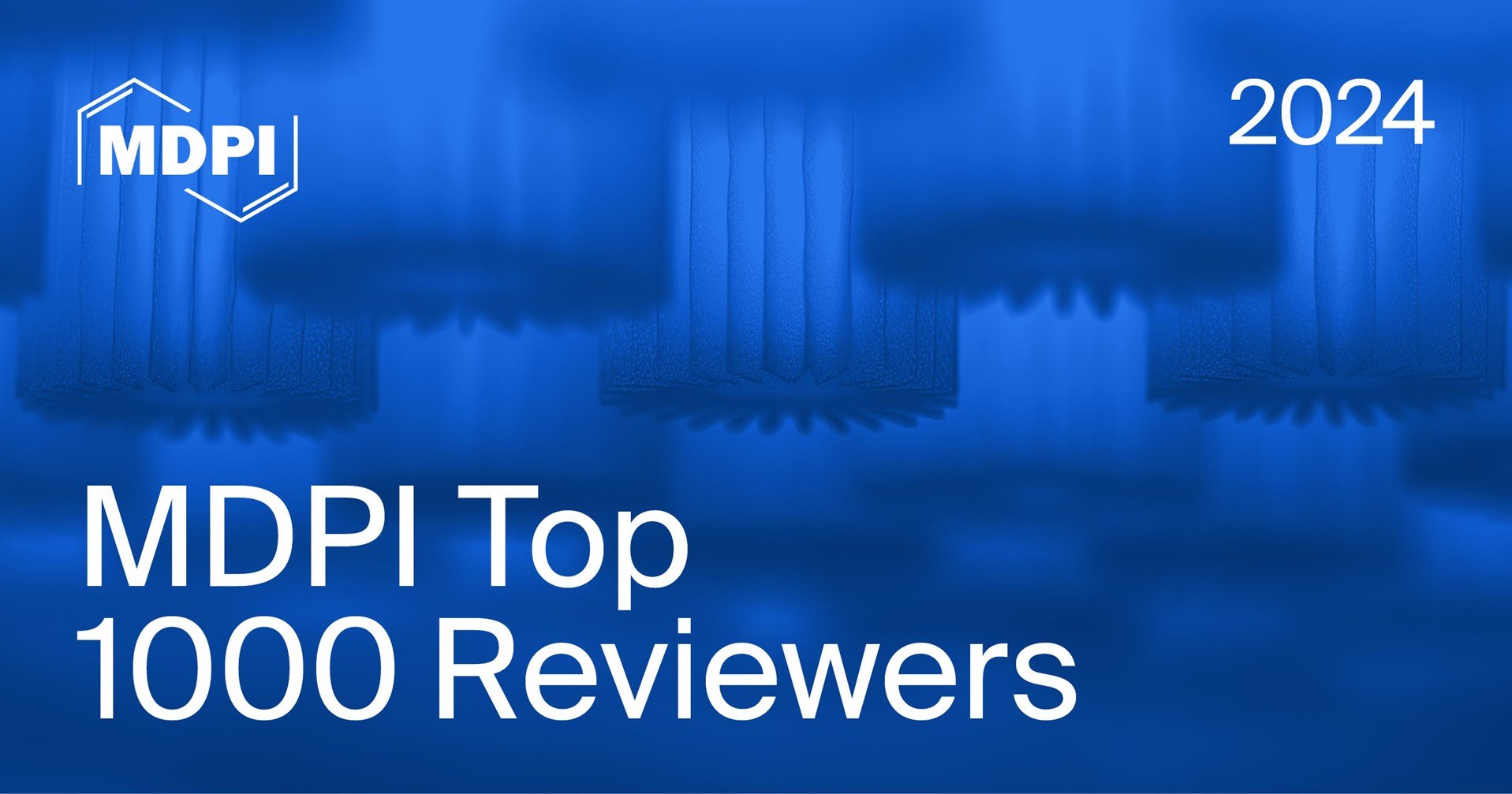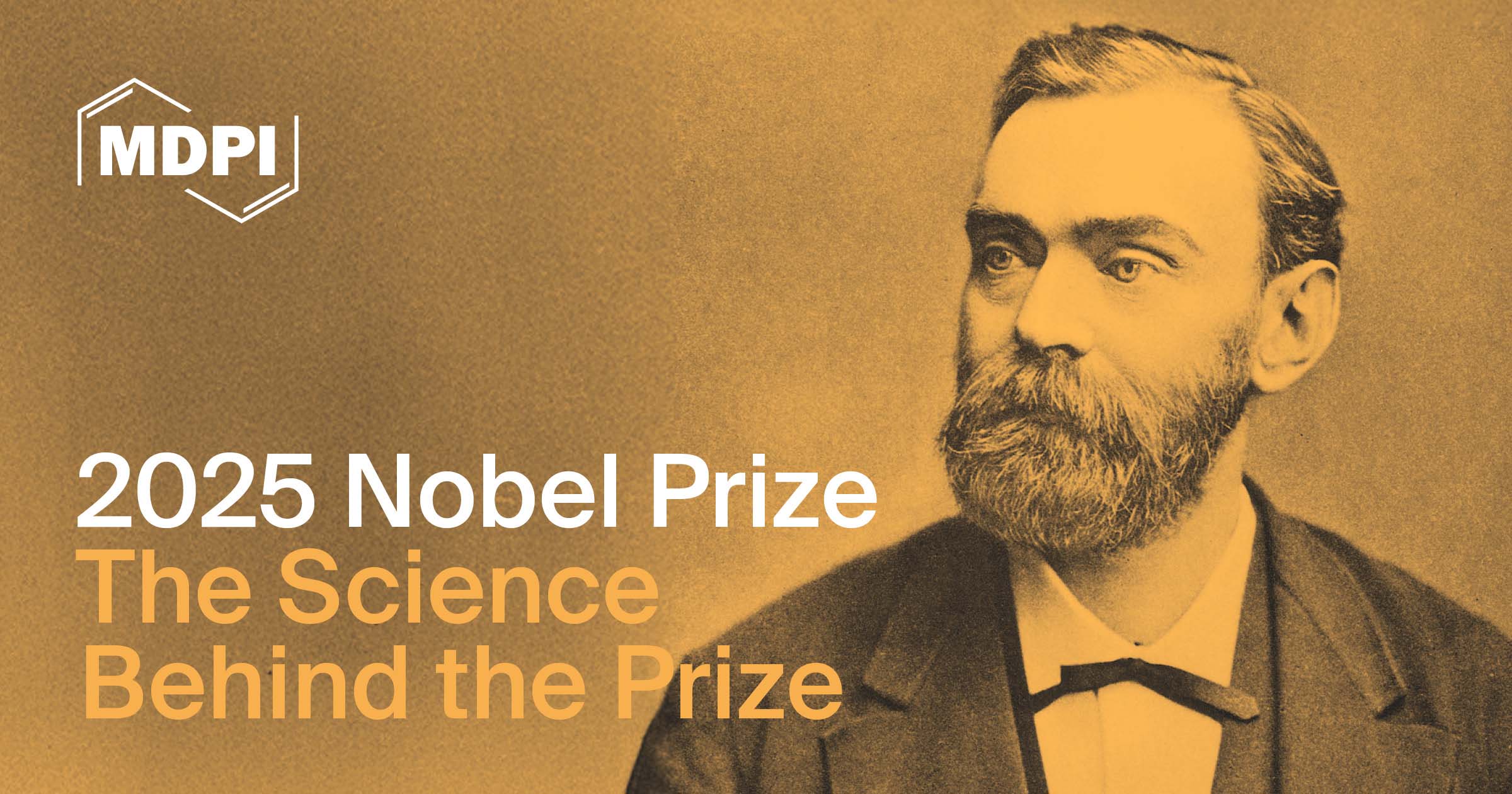Journal Description
Journal of Personalized Medicine
Journal of Personalized Medicine
is an international, peer-reviewed, open access journal on personalized medicine, published monthly online by MDPI. The Inter-American Society for Minimally Invasive Spine Surgery (SICCMI), Korean Society of Brain Neuromodulation Therapy (KBNT) and American Board of Precision Medicine (ABOPM) are affiliated with JPM, and their members receive a discount on article processing charges.
- Open Access— free for readers, with article processing charges (APC) paid by authors or their institutions.
- High Visibility: indexed within Scopus, PubMed, PMC, Embase, and other databases.
- Journal Rank: CiteScore - Q1 (Medicine (miscellaneous))
- Rapid Publication: manuscripts are peer-reviewed and a first decision is provided to authors approximately 21.5 days after submission; acceptance to publication is undertaken in 3.5 days (median values for papers published in this journal in the first half of 2025).
- Recognition of Reviewers: reviewers who provide timely, thorough peer-review reports receive vouchers entitling them to a discount on the APC of their next publication in any MDPI journal, in appreciation of the work done.
Latest Articles
Current Applications and Future Directions of Technologies Used in Adult Deformity Surgery for Personalized Alignment: A Narrative Review
J. Pers. Med. 2025, 15(10), 480; https://doi.org/10.3390/jpm15100480 - 3 Oct 2025
Abstract
Patient-specific technologies within the field of adult spinal deformity (ASD) aid surgeons in pre-surgical planning, accurately help identify anatomical landmarks, and can project optimal post-surgical sagittal alignment. This narrative review aims to discuss the current uses of patient-specific technologies in ASD and identify
[...] Read more.
Patient-specific technologies within the field of adult spinal deformity (ASD) aid surgeons in pre-surgical planning, accurately help identify anatomical landmarks, and can project optimal post-surgical sagittal alignment. This narrative review aims to discuss the current uses of patient-specific technologies in ASD and identify new innovations that may very soon be integrated into patient care. Pre-operatively, machine learning or artificial intelligence helps surgeons to simulate post-operative alignment and provide information for the 3D-printing of pre-contoured rods and patient-specific cages. Intraoperatively, robotic surgery and intraoperative guides allow for more accurate positioning of implants. Implant materials are being developed to allow for better osseointegration and patient outcome monitoring. Despite the significant promise of these technologies, work still needs to be performed to ensure their accuracy, safety, and cost efficacy.
Full article
(This article belongs to the Special Issue Personalized Approaches in Spinal Deformity: Innovations in Diagnosis and Treatment)
Open AccessArticle
ICU Readmission and In-Hospital Mortality Rates for Patients Discharged from the ICU—Risk Factors and Validation of a New Predictive Model: The Worse Outcome Score (WOScore)
by
Eleftherios Papadakis, Athanasia Proklou, Sofia Kokkini, Ioanna Papakitsou, Ioannis Konstantinou, Aggeliki Konstantinidi, Georgios Prinianakis, Stergios Intzes, Marianthi Symeonidou and Eumorfia Kondili
J. Pers. Med. 2025, 15(10), 479; https://doi.org/10.3390/jpm15100479 - 3 Oct 2025
Abstract
Background: Intensive Care Unit (ICU) readmission and in-hospital mortality are critical indicators of patient outcomes following ICU discharge. Patients readmitted to the ICU often face worse prognosis, higher healthcare costs, and prolonged hospital stays. Identifying high-risk patients is essential for optimizing post-ICU
[...] Read more.
Background: Intensive Care Unit (ICU) readmission and in-hospital mortality are critical indicators of patient outcomes following ICU discharge. Patients readmitted to the ICU often face worse prognosis, higher healthcare costs, and prolonged hospital stays. Identifying high-risk patients is essential for optimizing post-ICU care and resource allocation. Methods: This two-phase study included the following: (1) a retrospective analysis of ICU survivors in a mixed medical–surgical ICU to identify risk factors associated with ICU readmission and in-hospital mortality, and (2) a prospective validation of a newly developed predictive model: the Worse Outcome Score (WOScore). Data collected included demographics, ICU admission characteristics, severity scores (SAPS II, SAPS III, APACHE II, SOFA), interventions, complications and discharge parameters. Results: Among 1.190 ICU survivors, 126 (10.6%) were readmitted to the ICU, and 192 (16.1%) died in hospital after ICU discharge. Key risk factors for ICU readmission included Diabetes Mellitus, SAPS III on admission, and ICU-acquired infections (Ventilator-Associated Pneumonia (VAP) and Catheter-Related Bloodstream Infection, (CRBSI)). Predictors of in-hospital mortality were identified: medical admission, high SAPS III score, high lactate level on ICU admission, tracheostomy, reduced GCS at discharge, blood transfusion, CRBSI, and Acute Kidney Injury (AKI) during ICU stay. The WOScore, developed based on the results above, demonstrated strong predictive ability (AUC: 0.845 derivation, 0.886 validation). A cut-off of 20 distinguished high-risk patients (sensitivity: 88.1%, specificity: 73.0%). Conclusions: ICU readmission and in-hospital mortality are influenced by patient severity, underlying comorbidities, and ICU-related complications. The WOScore provides an effective, easy-to-use risk stratification tool that can guide clinicians in identifying high-risk patients at ICU discharge and guide post-ICU interventions, potentially improving patients’ outcomes and optimizing resource allocation. Further multi-center studies are necessary to validate the model in diverse healthcare settings.
Full article
(This article belongs to the Section Personalized Medical Care)
►▼
Show Figures

Figure 1
Open AccessReview
Neuroanatomical and Functional Correlates in Depressive Spectrum: A Narrative Review
by
Giulio Perrotta, Anna Sara Liberati and Stefano Eleuteri
J. Pers. Med. 2025, 15(10), 478; https://doi.org/10.3390/jpm15100478 - 2 Oct 2025
Abstract
Depressive spectrum disorders are considered among the most common in the general population. Major depressive disorder and persistent depressive disorder (or dysthymia) are the most recognized, but other depressive disorders exist with varying or no specificity. The main difference between major depressive disorder
[...] Read more.
Depressive spectrum disorders are considered among the most common in the general population. Major depressive disorder and persistent depressive disorder (or dysthymia) are the most recognized, but other depressive disorders exist with varying or no specificity. The main difference between major depressive disorder and dysthymia lies in the duration and intensity of symptoms. Improving our understanding of its etiology and pathogenesis must be a priority for health and safety. Given the complexity of the evidence in the literature, it was deemed useful to provide a comprehensive summary of the neuroanatomical dysfunctions currently identified, with particular attention to the anterior and medial cingulate cortex, dorsolateral and ventromedial prefrontal cortex, posterior parietal cortex, insula, amygdala, and hippocampus. Significant neural network alterations include hyperconnectivity of the default mode network (DMN), impairment of the executive control network (ECN), and dysfunction of the salience network (Salience Network). Neurophysiological markers reveal frontal alpha asymmetries and front-striatal metabolic alterations. Studying neural correlates is essential to deepen our understanding of the depressive spectrum and the development of personalized therapeutic interventions, including noninvasive neurostimulation techniques and target-specific pharmacological therapies, opening new avenues for translational research in neuropsychiatric settings.
Full article
(This article belongs to the Special Issue Depression and Anxiety: Recent Advances in Personalized Treatment and Management)
►▼
Show Figures

Graphical abstract
Open AccessArticle
External Validation and Comparative Performance of the T.O.HO. and S.T.O.N.E. Scoring Systems for Predicting Stone-Free Outcomes Following Flexible Ureteroscopy: Toward Personalized Preoperative Counseling
by
Yuka Sugizaki, Takanobu Utsumi, Rino Ikeda, Naoki Ishitsuka, Takahide Noro, Yuta Suzuki, Shota Iijima, Takatoshi Somoto, Ryo Oka, Takumi Endo, Naoto Kamiya and Hiroyoshi Suzuki
J. Pers. Med. 2025, 15(10), 477; https://doi.org/10.3390/jpm15100477 - 2 Oct 2025
Abstract
Background/Objectives: The attainment of a stone-free (SF) condition is a fundamental indicator of successful outcomes after flexible ureteroscopy (fURS) for urinary stone disease. External confirmations of preoperative scores remain limited. We externally validated the T.O.HO. and S.T.O.N.E. scores in an independent Japanese
[...] Read more.
Background/Objectives: The attainment of a stone-free (SF) condition is a fundamental indicator of successful outcomes after flexible ureteroscopy (fURS) for urinary stone disease. External confirmations of preoperative scores remain limited. We externally validated the T.O.HO. and S.T.O.N.E. scores in an independent Japanese cohort and examined calibration, decision curve utility, and threshold-guided use to support personalized planning. Methods: We retrospectively analyzed 361 consecutive patients treated with fURS from March 2018 to August 2023. Postoperative SF status was defined as the absence of residual calculi greater than 2 mm on non-contrast computed tomography performed within three months of surgery. Independent determinants of SF were identified using multivariable logistic regression, predictive performance was quantified by receiver operating characteristic analyses with DeLong’s test, and model calibration and decision curve analysis were additionally assessed. Results: Among the 361 patients, 255 (70.6%) achieved an SF state. A larger stone diameter, the presence of lower-pole calculi, and preoperative pyuria (positive urine WBC) were significant independent predictors of residual fragments. T.O.HO. demonstrated superior discrimination (AUC 0.86) compared with S.T.O.N.E. (AUC 0.77; p < 0.01) and surpassed individual predictors. Both scores showed acceptable calibration. Decision curve analysis demonstrated higher net benefit for T.O.HO. across clinically relevant thresholds. We provide clinically useful cut-offs (e.g., T.O.HO. ≤5: high SF probability; 6: trade-off discussion; ≥7: higher residual risk) to align actions with patient priorities. Conclusions: Beyond discrimination, a calibrated, threshold-aware use of T.O.HO. enables personalized preoperative counseling and shared decision-making, potentially reducing unnecessary staging and enhancing routine fURS planning.
Full article
(This article belongs to the Section Personalized Medical Care)
►▼
Show Figures
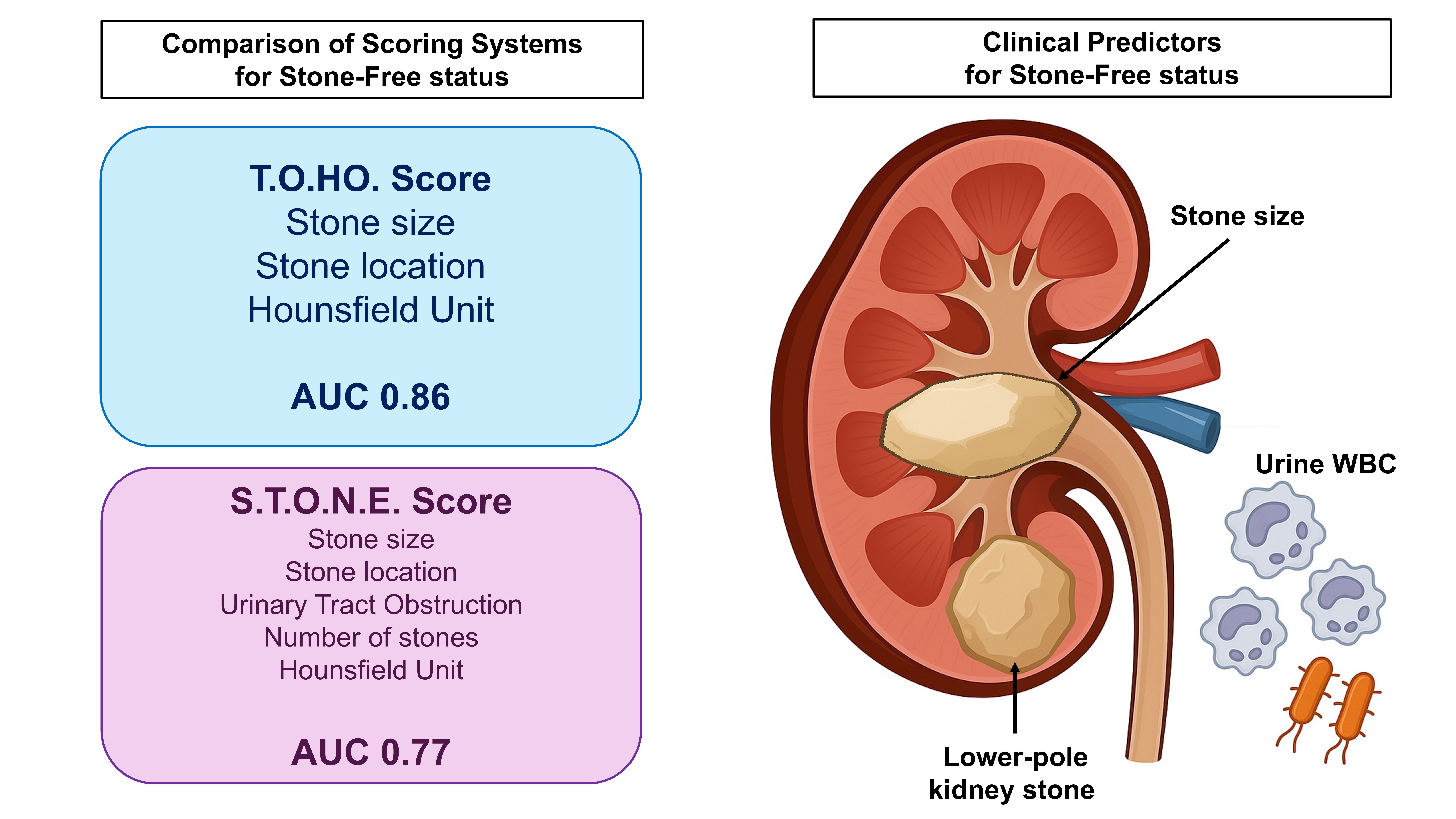
Graphical abstract
Open AccessArticle
Development and Internal Validation of Machine Learning Algorithms to Predict 30-Day Readmission in Patients Undergoing a C-Section: A Nation-Wide Analysis
by
Audrey Andrews, Nadia Islam, George Bcharah, Hend Bcharah and Misha Pangasa
J. Pers. Med. 2025, 15(10), 476; https://doi.org/10.3390/jpm15100476 - 2 Oct 2025
Abstract
Background/Objectives: Cesarean section (C-section) is a common surgical procedure associated with an increased risk of 30-day postpartum hospital readmissions. This study utilized machine learning (ML) to predict readmissions using a nationwide database. Methods: A retrospective analysis of the National Surgical Quality
[...] Read more.
Background/Objectives: Cesarean section (C-section) is a common surgical procedure associated with an increased risk of 30-day postpartum hospital readmissions. This study utilized machine learning (ML) to predict readmissions using a nationwide database. Methods: A retrospective analysis of the National Surgical Quality Improvement Project (2012–2022) included 54,593 patients who underwent C-sections. Random Forests (RF) and Extreme Gradient Boosting (XGBoost) models were developed and compared to logistic regression (LR) using demographic, preoperative, and perioperative data. Results: Of the cohort, 1306 (2.39%) patients were readmitted. Readmitted patients had higher rates of being of African American race (17.99% vs. 9.83%), diabetes (11.03% vs. 8.19%), and hypertension (11.49% vs. 4.68%) (p < 0.001). RF achieved the highest performance (AUC = 0.737, sensitivity = 72.03%, specificity: 61.33%), and a preoperative-only RF model achieved a sensitivity of 83.14%. Key predictors included age, BMI, operative time, white blood cell count, and hematocrit. Conclusions: ML effectively predicts C-section readmissions, supporting early identification and interventions to improve patient outcomes and reduce healthcare costs.
Full article
(This article belongs to the Special Issue Advances in Prenatal Diagnosis and Maternal Fetal Medicine)
►▼
Show Figures
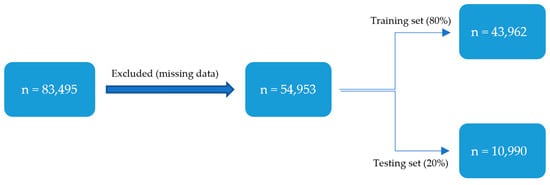
Figure 1
Open AccessArticle
Temporal Validation of a Plasma Diagnosis Approach for Early Alzheimer Disease Diagnosis in a Cognitive Disorder Unit
by
Aleix Martí-Navia, Alejandro López, Lourdes Álvarez-Sánchez, Laura Ferré-González, Angel Balaguer, Miguel Baquero and Consuelo Cháfer-Pericás
J. Pers. Med. 2025, 15(10), 475; https://doi.org/10.3390/jpm15100475 - 2 Oct 2025
Abstract
Background: Nowadays, there is a lack of reliable and minimally invasive diagnosis methods for the early detection of Alzheimer’s disease. The development and validation of such tools could significantly reduce the dependence on more invasive and costly confirmatory procedures, such as cerebrospinal
[...] Read more.
Background: Nowadays, there is a lack of reliable and minimally invasive diagnosis methods for the early detection of Alzheimer’s disease. The development and validation of such tools could significantly reduce the dependence on more invasive and costly confirmatory procedures, such as cerebrospinal fluid biomarkers analysis and neuroimaging techniques. Objectives: The main objective of this study is to validate the clinical performance of a previously developed diagnosis model based on plasma biomarkers from patients in a cognitive disorder unit. Methods: A new cohort of patients was recruited from the same cognitive disorder unit (n = 93). Specifically, demographic data (gender, age, and educational level), plasma biomarkers levels, and genotype (glial fibrillary acidic protein, phosphorylated Tau 181, amyloid-beta42/amyloid-beta40, apolipoprotein E) were collected to evaluate both approaches of the previous diagnosis model (one-cut-off, two-cut-off). Results: The one-cut-off approach showed a sensitivity of 74.3%, a specificity of 89.5%, and an area under the curve of 0.888, while the values for the two-cut-off approach were sensitivity of 66.7%, specificity of 99.9%, and area under the curve of 0.867. Conclusions: A multivariate diagnostic tool was temporally validated for implementation in a clinical unit. In fact, satisfactory results were obtained from both approaches (one-cut-off, two-cut-offs), but the two cut-offs approach was more consistent in correctly identifying non-Alzheimer’s disease cases, allowing us to identify a large number of cases with high specificity.
Full article
(This article belongs to the Special Issue New Insight into Aging and Geriatric Syndromes: Clinical Updates and Perspectives)
►▼
Show Figures

Graphical abstract
Open AccessReview
Personalizing DNA Cancer Vaccines
by
Annie A. Wu, Kaiqi Peng, Melanie Vukovich, Michelle Zhu, Yuki Lin, Arindam Bagga, TC Wu and Chien-Fu Hung
J. Pers. Med. 2025, 15(10), 474; https://doi.org/10.3390/jpm15100474 - 2 Oct 2025
Abstract
Recent progress in tumor immunotherapy highlights the important role of the immune system in combating various cancers. Traditionally designed to protect against infectious diseases, vaccines are now being adapted to stimulate immune responses against tumor-specific neoantigens. Both preclinical studies and clinical trials have
[...] Read more.
Recent progress in tumor immunotherapy highlights the important role of the immune system in combating various cancers. Traditionally designed to protect against infectious diseases, vaccines are now being adapted to stimulate immune responses against tumor-specific neoantigens. Both preclinical studies and clinical trials have explored innovative approaches for identifying neoantigens and optimizing vaccine design, advancing the field of personalized oncology. Among these, DNA-based vaccines have become a particularly attractive approach for cancer immunotherapy. This evolution has been driven by improvements in molecular biology techniques, including more precise methods for detecting tumor-specific mutations, computational tools for predicting immunogenic antigens, and novel platforms for delivering nucleic acid vaccines. Personalized DNA vaccines are typically developed through a complex, multi-step process that involves sequencing a patient’s tumor, computational analysis to identify potential targets, and custom vaccine production. In this review, we examine the use of both shared tumor antigens and individualized neoantigens in cancer vaccine development. We outline strategies for neoantigen identification that provide insights into tumor-specific alterations. Furthermore, we highlight recent advances in DNA vaccine technologies, address the current limitations facing cancer vaccines, propose strategies to overcome these challenges, and consider key clinical and technical factors for successful implementation.
Full article
(This article belongs to the Special Issue Cancer Immunotherapy: Current Advancements and Future Perspectives)
►▼
Show Figures
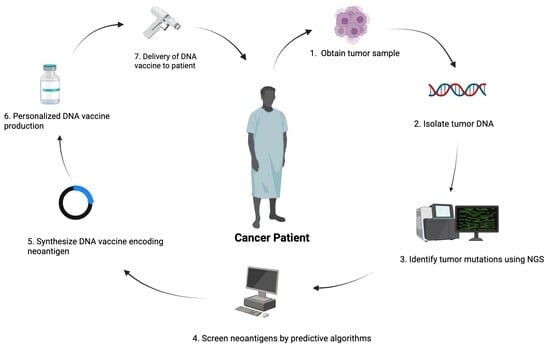
Graphical abstract
Open AccessArticle
Phenotype-Guided Outpatient Levosimendan as a Bridge-to-Transplant in Low-Output Advanced Heart Failure: A Single-Center Cohort
by
Ricardo Carvalheiro, Ana Raquel Santos, Ana Rita Teixeira, João Ferreira Reis, António Valentim Gonçalves, Rita Ilhão Moreira, Tiago Pereira da Silva, Valdemar Gomes, Pedro Coelho and Rui Cruz Ferreira
J. Pers. Med. 2025, 15(10), 473; https://doi.org/10.3390/jpm15100473 - 2 Oct 2025
Abstract
Background: Advanced heart failure (HF) carries high morbidity and mortality, and deterioration on the heart transplantation (HT) waiting list remains a major challenge. Intermittent outpatient levosimendan has been proposed as a bridge strategy, but the optimal regimen and its impact on peri-transplant
[...] Read more.
Background: Advanced heart failure (HF) carries high morbidity and mortality, and deterioration on the heart transplantation (HT) waiting list remains a major challenge. Intermittent outpatient levosimendan has been proposed as a bridge strategy, but the optimal regimen and its impact on peri-transplant outcomes remain uncertain. Within a personalized-medicine framework, we targeted a low-output/INTERMACS 3 phenotype and operationalized an adaptable, protocolized levosimendan pathway focused on perfusion/congestion stabilization to preserve transplant candidacy. Methods: We conducted a single-center, retrospective cohort study of 25 consecutive adults actively listed for HT between 2019 and 2024, treated with a standardized outpatient program of a 14-day interval of 6 h intravenous levosimendan infusions (target 0.2 μg/kg/min infusions) continued until transplant. Personalization in this program was operationalized through (i) phenotype-based eligibility (low CI and elevated filling pressures despite GDMT), (ii) predefined titration and safety rules for blood pressure, arrhythmias, and renal function, and (iii) individualized continuation until transplant with nurse-supervised monitoring and review of patient trajectories. Baseline characteristics, treatment exposure and safety, changes in hospitalizations and biomarkers, and peri-transplant outcomes were analyzed. Results: Patients were predominantly male (68%), with a mean age of 47.9 ± 17.5 years and severe LV dysfunction (LVEF 30.6 ± 9.8%). Median treatment duration was 131 days (IQR 60–241). No infusions required discontinuation for hypotension or arrhythmia, and no adverse events were directly attributed to levosimendan. Two patients (8%) died on the waiting list, both unrelated to therapy. During treatment, HF hospitalizations decreased significantly compared with the previous 6 months (48% vs. 20%, p = 0.033), renal function remained stable, and NT-proBNP trended downward. Of the 23 patients transplanted, two (9%) underwent urgent HT during decompensation. Post-transplant, vasoplegia occurred in 26% (n = 6 of 23), and 30-day mortality was 9% (n = 2 of 23). Conclusions: By defining the target phenotype, therapeutic goals, and adaptation rules, this study shows how a standardized but flexible outpatient levosimendan regimen can function as a personalized bridge strategy for low-output advanced HF. The approach was associated with fewer hospitalizations, stable renal function, and acceptable peri-transplant outcomes, and merits confirmation in multicenter cohorts with attention to patient heterogeneity and treatment effect refinement.
Full article
(This article belongs to the Special Issue Personalized Treatment for Heart Failure)
►▼
Show Figures

Figure 1
Open AccessReview
Cardiac Amyloidosis: Tribulations and New Frontiers
by
Darren M. Nguyen, Noyan Ramazani, Gurpreet Sodhi and Tahir Tak
J. Pers. Med. 2025, 15(10), 472; https://doi.org/10.3390/jpm15100472 - 2 Oct 2025
Abstract
This review article aims to provide an overview of the pathophysiology, diagnosis, and contemporary management of cardiac amyloidosis (CA) as well as identify the knowledge gaps and areas of potential research. CA can be divided into two main groups: transthyretin cardiac amyloidosis (ATTR-CA)
[...] Read more.
This review article aims to provide an overview of the pathophysiology, diagnosis, and contemporary management of cardiac amyloidosis (CA) as well as identify the knowledge gaps and areas of potential research. CA can be divided into two main groups: transthyretin cardiac amyloidosis (ATTR-CA) and light chain cardiac amyloidosis (AL-CA). The former further separates into wild-type transthyretin (ATTRwt) and hereditary transthyretin (ATTRv). African Americans, males, and people older than 75 are the most common demographics affected by this disease. Thanks to an increased understanding of this disease combined with better diagnostic techniques, there is growing awareness and a surge of clinical trials aimed at improving outcomes of CA. The diagnosis and treatment of CA is multifaceted and complex, relying on multiple imaging modalities and the cooperation of specialists to deliver effective treatments. While some disease-modifying agents have been introduced recently, their extraordinary cost limits their benefit or they are supported by limited evidence. Other agents are currently undergoing phase 3 trials. To date, there is scarce data surrounding optimal diagnostic and treatment strategies, including a potential role for combination therapies. Critically, it is imperative that physicians develop close relationships with the patient that addresses not only their individual health needs but also their unique psychosocial situation. Therefore, more clinical trials, protocols and patient resources are needed to better inform and guide providers managing these complex patient needs.
Full article
(This article belongs to the Section Mechanisms of Diseases)
►▼
Show Figures
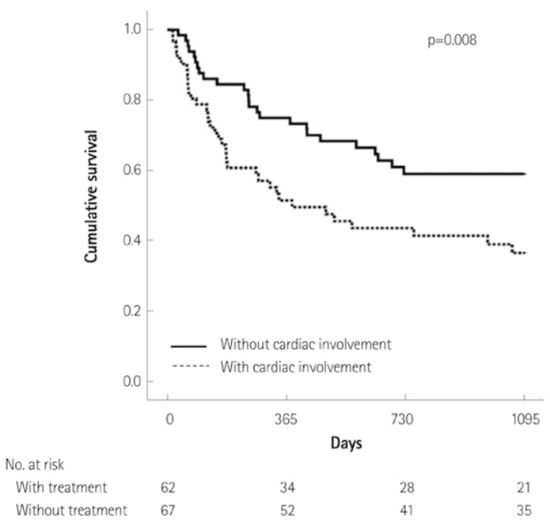
Figure 1
Open AccessArticle
Comorbidities as a Personalized Target in Patients with Severe Asthma Treated with Dupilumab
by
Carlota Gonzalez-Lluch, Maria Basagaña, Laura Pardo, Paula Cruz Toro, Agnes Hernandez-Biette, Carlos Martinez-Rivera and Ignasi Garcia-Olive
J. Pers. Med. 2025, 15(10), 471; https://doi.org/10.3390/jpm15100471 - 2 Oct 2025
Abstract
Background: This study aimed to evaluate the clinical effectiveness of dupilumab and its impact on CRSwNP and type 2 inflammatory biomarkers in patients with severe uncontrolled asthma, with or without comorbidities, within a real-life cohort. Methods: This was a single-center, prospective, and observational
[...] Read more.
Background: This study aimed to evaluate the clinical effectiveness of dupilumab and its impact on CRSwNP and type 2 inflammatory biomarkers in patients with severe uncontrolled asthma, with or without comorbidities, within a real-life cohort. Methods: This was a single-center, prospective, and observational real-life study conducted at the Severe Asthma Unit of Germans Trias i Pujol University Hospital. The objective of this study was to assess the real-world response to dupilumab treatment in patients with severe asthma, with or without nasal polyposis, bronchiectasis, obesity, or switching from another biologic drug for their asthma. Results: The ACT score significantly increased (13.7 vs. 20.6; p = 0.001), while the number of exacerbations decreased (3.1 vs. 0.7; p = 0.005). Patients with CRSwNP showed an increase in the ACT score (13.1 vs. 19.8; p = 0.011) and a decrease in the number of exacerbations (3.0 vs. 1.3; p = 0.217). Patients with nasal polyps showed an increase in both SNOT22 (78.3 vs. 38.3; p = 0.013) and global VAS (8 vs. 4.2; p = 0.028). Patients with bronchiectasis receiving dupilumab showed an increase in the ACT score (12.7 vs. 21.3; p = 0.039) and a marked decrease in the number of exacerbations (2.8 vs. 0; p = 0.025). Obese patients treated with dupilumab showed an improvement in the ACT score (14.1 vs. 21.3; p = 0.044) and a decrease in the rate of exacerbations (3.2 vs. 1.3; p = 0.030). Patients with rhinoconjunctivitis receiving dupilumab showed an increase in the ACT score (13.4 vs. 19.1; p = 0.017) and a decrease in the number of exacerbations (3.3 vs. 0.8; p = 0.024). Conclusions: Dupilumab is a highly effective treatment for severe asthma, showing significant improvements in lung function, reductions in exacerbations, and enhanced quality of life for patients with and without nasal polyps. The results of this real-life study support dupilumab as a valuable addition to the therapeutic armamentarium for asthma, particularly for those with type 2 inflammation despite the presence of comorbidities such as bronchiectasis or obesity, or for patients in whom a previous biologic treatment failed.
Full article
(This article belongs to the Special Issue Novel Therapeutic Approaches to Asthma in Clinical Medicine)
Open AccessArticle
Low Radiation Doses to Gross Tumor Volume in Metabolism Guided Lattice Irradiation Based on Lattice-01 Study: Dosimetric Evaluation and Potential Clinical Research Implication
by
Giuseppe Iatì, Giacomo Ferrantelli, Stefano Pergolizzi, Gianluca Ferini, Valeria Venuti, Federico Chillari, Miriam Sciacca, Valentina Zagardo, Carmelo Siragusa, Anna Santacaterina, Anna Brogna and Silvana Parisi
J. Pers. Med. 2025, 15(10), 470; https://doi.org/10.3390/jpm15100470 - 2 Oct 2025
Abstract
Purpose: This paper aims to calculate the gross tumor volume (GTV) receiving low radiation doses in patients submitted to “metabolism-guided” lattice radiation therapy and relative possible implications with clinical outcomes. Material and Methods: We reviewed plans for treating voluminous masses via
[...] Read more.
Purpose: This paper aims to calculate the gross tumor volume (GTV) receiving low radiation doses in patients submitted to “metabolism-guided” lattice radiation therapy and relative possible implications with clinical outcomes. Material and Methods: We reviewed plans for treating voluminous masses via “metabolism-guided” LATTICE-01 irradiation. The aim was to deliver high-dose radiation to spherical deposits (vertices) within a bulky tumor mass. These were placed at tumor areas with differing PET metabolism. We evaluated the relationships between GTV volumes and dose-volumetric histograms (mean, maximum, minimum, and % GTV received 0.5, 1, 2, 3 Gy). Results: Sixty-two plans of treatment met the inclusion criteria as established. The median GTV volume was 315.9 cc (range = 10.54–2605.9 cc). A median of two Vertices was allocated within the GTVs (range 1–9) and were planned to receive a dose of ≥10 Gy/1 fraction (median 12 Gy, range 10–15 Gy). Median V3Gy percentage was 51.58% (range 2–100%), median V2Gy percentage was 67.80% (range 1.60–100%), median V1Gy percentage was 83.70% (range 0.80–100%), and median V0.5Gy percentage was 88.49% (range 17.60–100%). Conclusions: In the present series, we performed a dosimetric evaluation of the GTV’s volume exposed to low doses during the metabolic guided lattice irradiation process. Combining high- and low-dose radiotherapy based on a spatially fractionated (LATTICE) approach could reactivate the immune system against cancer cells. These observations could be useful for planning prospective studies on immunotherapy combined with the lattice technique.
Full article
(This article belongs to the Special Issue Personalized Radiation Therapy for Cancers: Current Status and Future Perspectives)
►▼
Show Figures

Figure 1
Open AccessArticle
Implementation of an Alzheimer’s Disease Blood Test: Adoption Experience by Memory Care Specialists in a Multi-Center Study
by
Mark Monane, Robert M. Carlile, Kim G. Johnson, Darren R. Gitelman, Lawren A. VandeVrede, Demetrius M. Maraganore, David A. Merrill, Leslie Jacobs, Justine Coppinger, Philip B. Verghese, Tim West and Joel B. Braunstein
J. Pers. Med. 2025, 15(10), 469; https://doi.org/10.3390/jpm15100469 - 1 Oct 2025
Abstract
Background/Objectives: A high-performing blood biomarker (BBM) test for Alzheimer’s disease (AD) represents an accurate, accessible, and scalable tool to aid healthcare professionals (HCPs) evaluating patients presenting with signs or symptoms of mild cognitive impairment (MCI) or dementia. However, implementation of AD blood tests
[...] Read more.
Background/Objectives: A high-performing blood biomarker (BBM) test for Alzheimer’s disease (AD) represents an accurate, accessible, and scalable tool to aid healthcare professionals (HCPs) evaluating patients presenting with signs or symptoms of mild cognitive impairment (MCI) or dementia. However, implementation of AD blood tests into clinical practice has not been extensively evaluated. The objective of this study was to assess the implementation of the multi-analyte PrecivityAD2™ blood test (C2N Diagnostics, LLC, St. Louis, MO, USA) into the clinical workflow of memory care clinics. Methods: A total of 8 HCPs (neurologists, geriatricians, geriatric psychiatrists) who served as site directors from 8 outpatient sites that evaluated 203 cognitively symptomatic patients were included in this sub-study of the real-world QUIP II Study (NCT06025877). Implementation of this blood test was assessed through surveying these HCPs using published frameworks including the Technology Acceptance Model, net promoter score, and forced choice preference questions. These assessments were analyzed using Wilcoxon signed-rank test, Fisher’s Exact test, and Wilcoxon signed-rank test, respectively. Results: HCPs reported acceptance scores that averaged 9.6 out of 10 (p < 0.0001, effect size 0.840): the test’s contribution to clinical decision-making as well as the ease of understanding test results received the highest ratings. The net promoter score was 75 (p < 0.0001), exceeding the typical benchmark of 30 reported as good levels of satisfaction in healthcare settings. The APS2 results and individual blood analyte results were rated with similar preference around their roles in HCP clinical decision-making. Conclusions: The results indicate early evidence of user acceptance and recognition by HCPs that this AD blood test can personalize the clinical care pathway for evaluating cognitively symptomatic patients.
Full article
(This article belongs to the Special Issue Personalized Treatment of Neurological Diseases)
Open AccessArticle
Digital Tools for Decision Support in Social Rehabilitation
by
Valeriya Gribova and Elena Shalfeeva
J. Pers. Med. 2025, 15(10), 468; https://doi.org/10.3390/jpm15100468 - 1 Oct 2025
Abstract
Objectives: The process of social rehabilitation involves several stages, from assessing an individual’s condition and determining their potential for rehabilitation to implementing a personalized plan with continuous monitoring of progress. Advances in information technology, including artificial intelligence, enable the use of software-assisted
[...] Read more.
Objectives: The process of social rehabilitation involves several stages, from assessing an individual’s condition and determining their potential for rehabilitation to implementing a personalized plan with continuous monitoring of progress. Advances in information technology, including artificial intelligence, enable the use of software-assisted solutions for objective assessments and personalized rehabilitation strategies. The research aims to present interconnected semantic models that represent expandable knowledge in the field of rehabilitation, as well as an integrated framework and methodology for constructing virtual assistants and personalized decision support systems based on these models. Materials and Methods: The knowledge and data accumulated in these areas require special tools for their representation, access, and use. To develop a set of models that form the basis of decision support systems in rehabilitation, it is necessary to (1) analyze the domain, identify concepts and group them by type, and establish a set of resources that should contain knowledge for intellectual support; (2) create a set of semantic models to represent knowledge for the rehabilitation of patients. The ontological approach, combined with the cloud cover of the IACPaaS platform, has been proposed. Results: This paper presents a suite of semantic models and a methodology for implementing decision support systems capable of expanding rehabilitation knowledge through updated regulatory frameworks and empirical data. Conclusions: The potential advantage of such systems is the combination of the most relevant knowledge with a high degree of personalization in rehabilitation planning.
Full article
(This article belongs to the Section Personalized Medical Care)
►▼
Show Figures

Figure 1
Open AccessArticle
Enhancing Automated Breast Cancer Detection: A CNN-Driven Method for Multi-Modal Imaging Techniques
by
Khadija Aguerchi, Younes Jabrane, Maryam Habba, Mustapha Ameur and Amir Hajjam El Hassani
J. Pers. Med. 2025, 15(10), 467; https://doi.org/10.3390/jpm15100467 - 1 Oct 2025
Abstract
Background/Objectives: Breast cancer continues to be one of the primary causes of death among women worldwide, emphasizing the necessity for accurate and efficient diagnostic approaches. This work focuses on developing an automated diagnostic framework based on convolutional neural networks (CNNs) capable of handling
[...] Read more.
Background/Objectives: Breast cancer continues to be one of the primary causes of death among women worldwide, emphasizing the necessity for accurate and efficient diagnostic approaches. This work focuses on developing an automated diagnostic framework based on convolutional neural networks (CNNs) capable of handling multiple imaging modalities. Methods: The proposed CNN model are trained and evaluated on several benchmark datasets, including mammography (DDSM, MIAS, INbreast), ultrasound, magnetic resonance imaging (MRI), and histopathology (BreaKHis). Standardized preprocessing procedures were applied across all datasets, and the outcomes were compared with leading state-of-the-art techniques. Results: The model attained strong classification performance with accuracy scores of 99.2% (DDSM), 98.97% (MIAS), 99.43% (INbreast), 98.00% (Ultrasound), 98.43% (MRI), and 86.42% (BreaKHis). These findings indicate superior results compared to many existing approaches, confirming the robustness of the method. Conclusions: This study introduces a reliable and scalable diagnostic system that can support radiologists in early breast cancer detection. Its high accuracy, efficiency, and adaptability across different imaging modalities make it a promising tool for integration into clinical practice.
Full article
(This article belongs to the Special Issue Advanced Imaging and Artificial Intelligence in Personalized Medicine: Innovations and Future Directions)
►▼
Show Figures

Figure 1
Open AccessArticle
Functional Impairment in Behavioral Variant Frontotemporal Dementia: Cognitive, Behavioral, Personality, and Brain Perfusion Contributions
by
Electra Chatzidimitriou, Georgios Ntritsos, Roza Lagoudaki, Eleni Poptsi, Emmanouil Tsardoulias, Andreas L. Symeonidis, Magda Tsolaki, Eleni Konstantinopoulou, Kyriaki Papadopoulou, Panos Charalambous, Katherine P. Rankin, Eleni Aretouli, Chrissa Sioka, Ioannis Iakovou, Theodora Afrantou, Panagiotis Ioannidis and Despina Moraitou
J. Pers. Med. 2025, 15(10), 466; https://doi.org/10.3390/jpm15100466 - 1 Oct 2025
Abstract
Background/Objectives: Behavioral variant frontotemporal dementia (bvFTD), the most prevalent clinical subtype within the frontotemporal lobar degeneration spectrum disorders, is characterized by early and prominent changes that significantly disrupt everyday functioning. This study aims to identify the key correlates of functional status in bvFTD
[...] Read more.
Background/Objectives: Behavioral variant frontotemporal dementia (bvFTD), the most prevalent clinical subtype within the frontotemporal lobar degeneration spectrum disorders, is characterized by early and prominent changes that significantly disrupt everyday functioning. This study aims to identify the key correlates of functional status in bvFTD by investigating the relative contributions of cognitive deficits, behavioral disturbances, personality changes, and brain perfusion abnormalities. Additionally, it seeks to develop a theoretical framework to elucidate how these factors may interconnect and shape unique functional profiles. Methods: A total of 26 individuals diagnosed with bvFTD were recruited from the 2nd Neurology Clinic of “AHEPA” University Hospital in Thessaloniki, Greece, and underwent a comprehensive neuropsychological assessment to evaluate their cognitive functions. Behavioral disturbances, personality traits, and functional status were rated using informant-based measures. Regional cerebral blood flow was assessed using Single Photon Emission Computed Tomography (SPECT) imaging to evaluate brain perfusion patterns. Penalized Least Absolute Shrinkage and Selection Operator (LASSO) regression analysis was performed to identify the most robust correlates of functional impairment, followed by path analyses using structural equation modeling to explore how these factors may interrelate and contribute to functional disability. Results: The severity of negative behavioral symptoms (e.g., apathy), conscientiousness levels, and performance on neuropsychological measures of semantic verbal fluency, visual attention, visuomotor speed, and global cognition were identified as the strongest correlates of performance in activities of daily living. Neuroimaging analysis revealed hypoperfusion in the right prefrontal (Brodmann area 8) and inferior parietal (Brodmann area 40) cortices as statistically significant neural correlates of functional impairment in bvFTD. Path analyses indicated that reduced brain perfusion was associated with attentional and processing speed deficits, which were further linked to more severe negative behavioral symptoms. These behavioral disturbances were subsequently correlated with declines in global cognition and conscientiousness, which were ultimately associated with poorer daily functioning. Conclusions: Hypoperfusion in key prefrontal and parietal regions, along with the subsequent cognitive and neuropsychiatric manifestations, appears to be associated with the pronounced functional limitations observed in individuals with bvFTD, even in early stages. Understanding the key determinants of the disease can inform the development of more targeted, personalized treatment strategies aimed at mitigating functional deterioration and enhancing the quality of life for affected individuals.
Full article
(This article belongs to the Special Issue Personalized Diagnosis and Treatment for Neurological Diseases)
►▼
Show Figures

Figure 1
Open AccessArticle
Transoral Cordectomy with Microelectrodes (TOMES) on an Outpatient Basis: Advancing Patient Comfort and Personalized Care Through Predictive Models
by
Cristina Rodríguez-Prado, Natsuki Oishi, Ernesto Fernández-Vidal, José Ramón Alba-García and Enrique Zapater
J. Pers. Med. 2025, 15(10), 465; https://doi.org/10.3390/jpm15100465 - 1 Oct 2025
Abstract
Background/Objectives: Outpatient surgery enhances patient comfort while reduces surgical wait times and healthcare costs compared to inpatient procedures. This study evaluates the individual feasibility of performing transoral trans muscular cordectomies with microelectrodes (TOMES) on an outpatient basis. Methods: This observational study
[...] Read more.
Background/Objectives: Outpatient surgery enhances patient comfort while reduces surgical wait times and healthcare costs compared to inpatient procedures. This study evaluates the individual feasibility of performing transoral trans muscular cordectomies with microelectrodes (TOMES) on an outpatient basis. Methods: This observational study analyses TOMES types III, IV, and V cordectomies performed from January 2002 to December 2023. Key metrics include patient demographics, procedural details, incidence of bleeding, anticoagulation and other comorbidities. Results: Of the 143 procedures, 127 were cancer-related, while 16 were due to bilateral vocal cord paralysis. The average age was 65, with a predominantly male cohort (92%). Postoperative hemorrhage occurred in four cases, primarily among oncological patients, but there was no correlation with anticoagulation therapy. A personalized predictive model for bleeding risk was developed based on patient-specific characteristics and observed outcomes. Additionally, performing the procedure on an outpatient basis decreased healthcare costs and wait times for patients with T1/T2 glottic carcinoma. Conclusions: The findings indicate that TOMES type III or higher cordectomies can be safely performed on an outpatient basis, through the use of a personalized predictive model for each case and with appropriate postoperative monitoring. This approach has the potential to lower healthcare costs and improve patient quality of life through individualized assessments and structured risk analysis.
Full article
(This article belongs to the Special Issue Personalized Medicine for Otolaryngology (ENT))
►▼
Show Figures
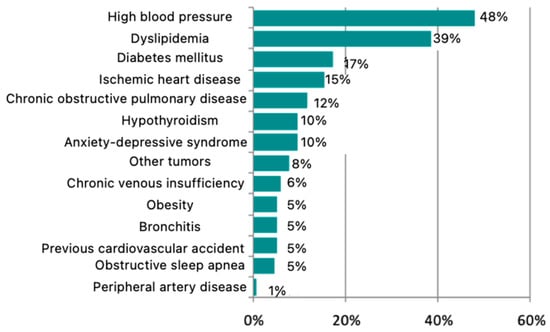
Figure 1
Open AccessArticle
Thrombus Imaging Features for Anterior Circulation Stroke: Their Impact on CTP Parameters and Natural Evolution of Infarct Progression
by
Bruna G. Dutra, Heitor C. B. R. Alves, Vivian Gagliardi, Rubens J. Gagliardi, Felipe T. Pacheco, Antonio C. M. Maia, Jr. and Antônio J. da Rocha
J. Pers. Med. 2025, 15(10), 464; https://doi.org/10.3390/jpm15100464 - 1 Oct 2025
Abstract
Background/Objectives: The relationship between thrombus imaging features and the natural evolution of stroke remains poorly defined. We aimed to investigate the associations between thrombus characteristics on CT and perfusion parameters, as well as subsequent infarct progression, in untreated patients experiencing an anterior
[...] Read more.
Background/Objectives: The relationship between thrombus imaging features and the natural evolution of stroke remains poorly defined. We aimed to investigate the associations between thrombus characteristics on CT and perfusion parameters, as well as subsequent infarct progression, in untreated patients experiencing an anterior circulation acute ischemic stroke (AIS). Methods: This retrospective analysis enrolled 81 untreated patients with AIS who underwent baseline non-contrast CT (NCCT), CT angiography (CTA), CT perfusion (CTP), and a follow-up NCCT. We evaluated the thrombus length, location, and clot burden score (CBS). CTP parameters included the ischemic core, hypoperfused tissue, and penumbra volumes. Infarct growth was the difference between the final infarct volume on a follow-up NCCT and the initial core volume on CTP. Univariate and multivariate regression models were performed. Results: Higher CBS values and shorter thrombi are associated with a reduced ischemic core (coefficients B of −3.9 and 0.88, p < 0.01), diminished hypoperfused tissue (coefficients B of −12.2 and 2.87, p < 0.001), and smaller penumbra volume (coefficients B of −7.9 and 1.99, p < 0.001). More distal occlusions were associated with smaller perfusion deficits. Importantly, a higher CBS and more distal thrombus location were significantly associated with a smaller final infarct volume and infarct growth volume. Conclusions: In untreated AIS patients, a lower thrombus burden (higher CBS, shorter length, distal location) is associated with more favorable baseline perfusion parameters and predicts a slower, less severe natural evolution of AIS. These findings underscore the prognostic value of baseline thrombus characteristics in determining the intrinsic course of a stroke.
Full article
(This article belongs to the Special Issue Personalized Diagnosis and Management of Stroke)
►▼
Show Figures
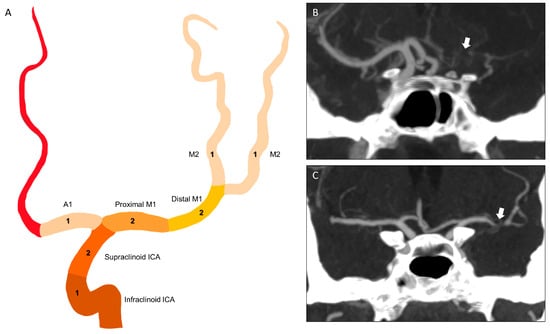
Figure 1
Open AccessArticle
Setting Up Our Lab-in-a-Box: Paving the Road Towards Remote Data Collection for Scalable Personalized Biometrics
by
Mona Elsayed, Jihye Ryu, Joseph Vero and Elizabeth B. Torres
J. Pers. Med. 2025, 15(10), 463; https://doi.org/10.3390/jpm15100463 - 1 Oct 2025
Abstract
Background: There is an emerging need for new scalable behavioral assays, i.e., assays that are feasible to administer from the comfort of the person’s home, with ease and at higher frequency than clinical visits or visits to laboratory settings can afford us today.
[...] Read more.
Background: There is an emerging need for new scalable behavioral assays, i.e., assays that are feasible to administer from the comfort of the person’s home, with ease and at higher frequency than clinical visits or visits to laboratory settings can afford us today. This need poses several challenges which we address in this work along with scalable solutions for behavioral data acquisition and analyses aimed at diversifying various populations under study here and to encourage citizen-driven participatory models of research and clinical practices. Methods: Our methods are centered on the biophysical fluctuations unique to the person and on the characterization of behavioral states using standardized biorhythmic time series data (from kinematic, electrocardiographic, voice, and video-based tools) in naturalistic settings, outside a laboratory environment. The methods are illustrated with three representative studies (58 participants, 8–70 years old, 34 males, 24 females). Data is presented across the nervous systems under a proposed functional taxonomy that permits data organization according to nervous systems’ maturation and decline levels. These methods can be applied to various research programs ranging from clinical trials at home, to remote pedagogical settings. They are aimed at creating new standardized biometric scales to screen and diagnose neurological disorders across the human lifespan. Results: Using this remote data collection system under our new unifying statistical platform for individualized behavioral analysis, we characterize the digital ranges of biophysical signals of neurotypical participants and report departure from normative ranges in neurodevelopmental and neurodegenerative disorders. Each study provides parameter spaces with self-emerging clusters whereby data points corresponding to a cluster are probability distribution parameters automatically classifying participants into different continuous Gamma probability distribution families. Non-parametric analysis reveals significant differences in distributions’ shape and scale (p < 0.01). Data reduction is realizable from full probability distribution families to a single parameter, the Gamma scale, amenable to represent each participant within each subclass, and each cluster of similar participants within each cohort. We report on data integration from stochastic analyses that serve to differentiate participants and propose new ways to highly scale our research, education, and clinical practices. Conclusions: This work highlights important methodological and analytical techniques for developing personalized and scalable biometrics across various populations outside a laboratory setting.
Full article
(This article belongs to the Special Issue Personalized Medicine in Neuroscience: Molecular to Systems Approach)
►▼
Show Figures

Figure 1
Open AccessSystematic Review
Personalized Medicine for Chronic Diseases Through the Integration of Health Determinants Control in Patients: A Systematic Review
by
Matthieu Bremond, Marie-Charlotte Raigneau, Joévin Burnel and Maxime Pautrat
J. Pers. Med. 2025, 15(10), 462; https://doi.org/10.3390/jpm15100462 - 30 Sep 2025
Abstract
Background: Chronic disease significantly contributes to global healthcare demands and costs. Despite these chronic illnesses, good health is achievable through public health strategies that enhance control over health determinants. This systematic review investigates how control over health determinants affects the health status
[...] Read more.
Background: Chronic disease significantly contributes to global healthcare demands and costs. Despite these chronic illnesses, good health is achievable through public health strategies that enhance control over health determinants. This systematic review investigates how control over health determinants affects the health status of individuals with chronic diseases. Objective: To assess the impact of limited control over health determinants on health status in people with chronic diseases and identify potential clinical applications. Methods: A systematic review was conducted following PRISMA 2020 and COSMOS-E guidelines. Searches across five databases (PubMed, Google Scholar, ScienceDirect, CINAHL, PsycARTICLES) between February and April 2023 identified cohort studies published in the last 10 years. Studies involving individuals aged 16 years and older with at least one chronic disease were included. The Newcastle–Ottawa scale was used to assess study quality. Results: Four cohort studies (n = 576) were included, involving participants with chronic diseases such as COPD, diabetes, and Parkinson’s disease. The methodological quality averaged 6/9. Significant correlations were observed between control over four health determinant domains—social, behavioral, biological, and healthcare system—and declining health outcomes. Common biases included detection and comparability bias. Discussion: The studies had acceptable methodological quality and low external bias risks. However, the meta-analysis was compromised due to the heterogeneity observed in the exposure variables of the included articles. The review emphasizes the importance of integrating control over health determinants into patient care, with healthcare professionals positioned to enhance patient control and improve outcomes. Conclusions: Lack of control over health determinants, particularly in social and behavioral domains, correlates with poorer health outcomes in patients with chronic conditions. Assessing and improve healthcare control could identify high-risk patients and improve their quality of life.
Full article
(This article belongs to the Section Personalized Medical Care)
►▼
Show Figures

Figure 1
Open AccessArticle
A Geometric Morphometrics Approach for Predicting Olfactory Region Accessibility: Toward Personalized Nose-to-Brain Drug Delivery
by
Priya Vishnumurthy, Thomas Radulesco, Gilles Bouchet, Alain Regard and Justin Michel
J. Pers. Med. 2025, 15(10), 461; https://doi.org/10.3390/jpm15100461 - 30 Sep 2025
Abstract
Background: The anatomical variability of the nasal cavity affects intranasal drug delivery, especially to the olfactory region for nose-to-brain treatments. While previous studies used average models or 2D measurements to account for inter-individual variability, 3D shape variation of the region crossed by drug
[...] Read more.
Background: The anatomical variability of the nasal cavity affects intranasal drug delivery, especially to the olfactory region for nose-to-brain treatments. While previous studies used average models or 2D measurements to account for inter-individual variability, 3D shape variation of the region crossed by drug particles that target the olfactory area, namely the region of interest (ROI), remains unexplored to our knowledge. Methods: A geometric morphometric analysis was performed on the ROI of 151 unilateral nasal cavities from the CT scans of 78 patients. Ten fixed landmarks and 200 sliding semi-landmarks were digitized, using Viewbox 4.0, and standardized via Generalized Procrustes Analysis. Shape variability was analyzed through Principal Component Analysis. Morphological clusters were identified using Hierarchical Clustering on Principal Components, and characterized with MANOVA, ANOVA, and Tukey tests. Results: Validation tests confirmed the method’s reliability. Three morphological clusters were identified. Variations were significant in the X and Y axes, and minimal in Z. Cluster 1 had a broader anterior cavity with shallower turbinate onset, likely improving olfactory accessibility. Cluster 3 was narrower with deeper turbinates, potentially limiting olfactory accessibility. Cluster 2 was intermediate. Notably, 31.5% of patients had at least one cavity in cluster 1. Conclusion: Three distinct morphotypes of the region of the nasal cavity that potentially influence accessibility were identified. These findings will guide future computational fluid dynamics studies for optimizing nasal drug targeting and represent a practical step toward tailoring nose-to-brain drug delivery strategies in alignment with the principles of personalized medicine.
Full article
(This article belongs to the Special Issue Otolaryngology in Clinical Practice: The Necessity of Personalized Medicine)

Journal Menu
► ▼ Journal Menu-
- JPM Home
- Aims & Scope
- Editorial Board
- Reviewer Board
- Topical Advisory Panel
- Instructions for Authors
- Special Issues
- Topics
- Sections & Collections
- Article Processing Charge
- Indexing & Archiving
- Editor’s Choice Articles
- Most Cited & Viewed
- Journal Statistics
- Journal History
- Journal Awards
- Society Collaborations
- Conferences
- Editorial Office
Journal Browser
► ▼ Journal BrowserHighly Accessed Articles
Latest Books
E-Mail Alert
News
Topics
Topic in
Antibiotics, JPM, Pharmaceuticals, Pharmaceutics, Medicines
Pharmacokinetic and Pharmacodynamic Modelling in Drug Discovery and Development
Topic Editors: Inaki F. Troconiz, Victor Mangas Sanjuán, Maria Garcia-Cremades MiraDeadline: 31 October 2025
Topic in
Biomedicines, JCM, JPM, Dermato
Current Challenges and Advances in Skin Repair and Regeneration
Topic Editors: Giovanni Salzano, Chiara CopelliDeadline: 1 December 2025
Topic in
Applied Sciences, IJERPH, JCM, JPM, Technologies, Healthcare
Smart Healthcare: Technologies and Applications, 2nd Edition
Topic Editors: Gang Kou, Shuai Ding, Li Luo, Tian Lu, Yogesan KanagasingamDeadline: 20 January 2026
Topic in
Biomedicines, Diagnostics, Endocrines, JCM, JPM, IJMS
Development of Diagnosis and Treatment Modalities in Obstetrics and Gynecology
Topic Editors: Osamu Hiraike, Fuminori TaniguchiDeadline: 20 March 2026

Conferences
Special Issues
Special Issue in
JPM
Personalized Medicine in Reproduction and Fertility
Guest Editor: Nikos K. NikolettosDeadline: 10 October 2025
Special Issue in
JPM
Exploiting Metabolic Weaknesses: A Novel Approach to Overcome Drug Resistance in Cancer Therapy
Guest Editor: Medhi WangpaichitrDeadline: 15 October 2025
Special Issue in
JPM
Novel Applications of Artificial Intelligence in Personalized Medicine
Guest Editor: Aikaterini SakagianniDeadline: 15 October 2025
Special Issue in
JPM
Multiple Biomarkers for the Diagnosis and Precision Treatment of Depression
Guest Editor: Angelos HalarisDeadline: 15 October 2025






